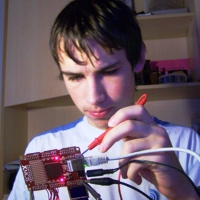Some help regarding flash choice please
I notice the XK1 uses a 4Mbit flash chip - AT25DF041A
Why does it use a 4Mbit flash rather than a 1Mbit given it only has 64K space for prog+data?
I notice that the USB ref design uses a 1Mbit AT25FS010N, does that mean this chip can be used with L1 designs? i.e. is it supported by the xmos libflash?
regards
Al
Flash choice for L1 boards
-
Folknology

- XCore Legend
- Posts: 1274
- Joined: Thu Dec 10, 2009 10:20 pm
-
leon_heller

- XCore Expert
- Posts: 546
- Joined: Thu Dec 10, 2009 10:41 pm
- Location: St. Leonards-on-Sea, E. Sussex, UK.
They probably had lots of the larger device for use with the bigger XMOS chips, and it was cheaper to use those than to place a separate order for the smaller device.
-
Berni

- Respected Member
- Posts: 363
- Joined: Thu Dec 10, 2009 10:17 pm
Yeah the 4 core devices need more memory, also the rest of the flash can be used to store your own data. Flash also got dirt cheep by now so a few extra bytes is always welcome. Also memory chips seam to be very standardized like the 25 being common in the part name of SPI memory, the pinouts are identical, package sizes are often only standard PDIP or SOIC, and the interface standard is very similar (There are sometimes differences between very big and very small devices because of the big ones needing more address bits)
-
richard
- Respected Member
- Posts: 318
- Joined: Tue Dec 15, 2009 12:46 am
libflash / xflash supports the following flash devices out of the box:
ALTERA_EPCS1
ATMEL_AT25DF041A
ST_M25PE10
ST_M25PE20
ATMEL_AT25FS010
These devices are supported on both the L1 and the G4. libflash can also be extended with new devices by providing a description of the of the flash device so long as the method of programming is similar enough to one devices listed above. For information about custom flash devices see the definition of the fl_DeviceSpec structure in flashlib.h and the following document:
The libflash Library (9.9)
ALTERA_EPCS1
ATMEL_AT25DF041A
ST_M25PE10
ST_M25PE20
ATMEL_AT25FS010
These devices are supported on both the L1 and the G4. libflash can also be extended with new devices by providing a description of the of the flash device so long as the method of programming is similar enough to one devices listed above. For information about custom flash devices see the definition of the fl_DeviceSpec structure in flashlib.h and the following document:
The libflash Library (9.9)
-
Folknology

- XCore Legend
- Posts: 1274
- Joined: Thu Dec 10, 2009 10:20 pm
Thanks Richard for clarifying the currently supported flash.
-
lilltroll

- XCore Expert
- Posts: 956
- Joined: Fri Dec 11, 2009 3:53 am
- Location: Sweden, Eskilstuna
"also the rest of the flash can be used to store your own data"
How do you burn extra data to the flash ?
How do you burn extra data to the flash ?
Probably not the most confused programmer anymore on the XCORE forum.
-
leon_heller

- XCore Expert
- Posts: 546
- Joined: Thu Dec 10, 2009 10:41 pm
- Location: St. Leonards-on-Sea, E. Sussex, UK.
Just write your own software within an application to access the unused portion of the chip.
-
Matt
- Active Member
- Posts: 50
- Joined: Sat Feb 13, 2010 12:04 pm
How do you determine what space is left and where you can start writing your own data to?
Matt
Matt
-
kster59
- XCore Addict
- Posts: 162
- Joined: Thu Dec 31, 2009 8:51 am
Use writepage/readpage from the libflash.
Libflash has a routine that tells you where the bootpartition ends.
Nice powerful library once you figure it out with the lack of docs.
Libflash has a routine that tells you where the bootpartition ends.
Nice powerful library once you figure it out with the lack of docs.
lilltroll wrote:"also the rest of the flash can be used to store your own data"
How do you burn extra data to the flash ?
-
lilltroll

- XCore Expert
- Posts: 956
- Joined: Fri Dec 11, 2009 3:53 am
- Location: Sweden, Eskilstuna
Why is the ALTERA EPCS1 so expensive ? Something special with it??
Probably not the most confused programmer anymore on the XCORE forum.
